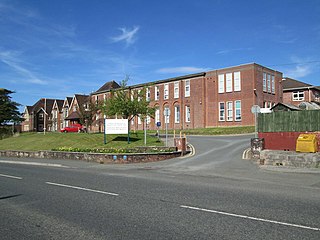
Powys is a county and preserved county in Wales. It borders Gwynedd, Denbighshire, and Wrexham to the north; the English ceremonial counties of Shropshire and Herefordshire to the east; Monmouthshire, Blaenau Gwent, Merthyr Tydfil, Caerphilly, Rhondda Cynon Taf, and Neath Port Talbot to the south; and Carmarthenshire and Ceredigion to the west. The largest settlement is Newtown, and the administrative centre is Llandrindod Wells.

Radnorshire was an administrative county in mid Wales, later classed as one of the thirteen historic counties of Wales and from 1974 to 1996 a district. It covered a sparsely populated area, and was bounded to the north by Montgomeryshire and Shropshire, to the east by Herefordshire, to the south by Brecknockshire and to the west by Cardiganshire.

Presteigne is a town and community on the south bank of the River Lugg in Powys, Wales. The town is located on the England–Wales border, which surrounds it to the north, east and south. Nearby towns are Kington, Herefordshire to the south and Knighton to the north, and surrounding villages include Norton and Stapleton. The community has a population of 2,710; the built-up area had a population of 2,056.

Llandrindod Wells is a town and community in Powys, Wales. It serves as the seat of Powys County Council, and is therefore the administrative centre of Powys. The town was historically in Radnorshire.

Brecon and Radnorshire was a county constituency in Wales of the House of Commons of the Parliament of the United Kingdom. Created in 1918, it elected one Member of Parliament (MP) by the first-past-the-post system of election.

Powys County Council is the local authority for Powys, one of the 22 principal areas of Wales. The council is based at County Hall in Llandrindod Wells.

Burfa Castle is an Iron Age hillfort near the tiny town of Old Radnor, Radnorshire in Powys, Wales. The site is a scheduled monument described as a prehistoric defensive hillfort, and was included in an inventory of monuments by 1913. The site is near Offa's Dyke which passes near the bottom of Burfa Bank.

Llanbadarn Fawr is a community in Powys, within the historic boundaries of Radnorshire, mid Wales. Consisting of a tract of undulating land directly north east of Llandrindod Wells, the community consists of the settlements of Crossgates and Fron and in 2001 had a population of 654, increasing to 701 at the 2011 Census. The community name comes from the local church.
Llanbister is a small village and community with a 2011 population of 382 in Powys, mid Wales, in the historic county of Radnorshire. It is on the river Ithon, at the junction of the A483 road and the B4356. It is served by Llanbister Road railway station on the Heart of Wales Line, but the station is some 4 miles east of the village.

Ysgol Calon Cymru is a bilingual secondary comprehensive school with campuses in Builth Wells and Llandrindod Wells, Powys, mid Wales. It replaced Builth Wells High School and Llandrindod High School and opened at the former schools' sites in September 2018.

Llandrindod Wells County War Memorial Hospital is a health facility in Temple Street, Llandrindod Wells, Powys, Wales. It is managed by the Powys Teaching Health Board.

The Shire Hall is a municipal structure in Broad Street, Presteigne, Powys, Wales. The building incorporates a well-preserved courtroom and a museum known as "the Judge's Lodging". Once the judicial centre for Radnorshire, is a Grade II* listed building.

Llandrindod Wells Library, is located in The Gwalia, which is a municipal building on Ithon Road, Llandrindod Wells, Powys, Wales. The structure, which was the headquarters of Radnorshire District Council, is now a customer service point for Powys County Council, and also features a public library. The building is a Grade II listed building.
The Radnorshire Challenge Cup is a football knockout tournament competed for by clubs either based within the Mid-Wales county boundary of Radnorshire or have a team in membership of the Mid Wales South League.

The Old Town Hall is a municipal building in Temple Street, Llandrindod Wells, Powys, Wales. The structure, which accommodates the offices of Llandrindod Wells Town Council, is a Grade II listed building.

Powys is a county and preserved county in Wales. It covers an area of 5,180 km2 (2,000 sq mi) and in 2021 the population was approximately 133,600.

Brecon, Radnor and Cwm Tawe is a constituency of the House of Commons in the UK Parliament, first contested at the 2024 United Kingdom general election, following the 2023 Periodic Review of Westminster constituencies.
Bryndraenog is a timber framed hall house dating from the medieval period in the community of Beguildy, Powys, Wales. It contains examples of wood carving of high quality, and was referenced by the poet Ieuan ap Hywel Swrdwal who called the house "proud maiden of lime and timber". The house is exceptionally well-preserved and is a Grade I listed building.

St Cewydd's Church is an active parish church in the village of Disserth, Powys, Wales. The dispersed village of Disserth lies south of Llandrindod Wells and north of Builth Wells. The church stands in an isolated position on a bank of the River Ithon. Unrestored in the Victorian era, the church has an unusually complete 18th century interior. Medieval in origin, St Cewydd's is designated by Cadw as a Grade I listed building.


















